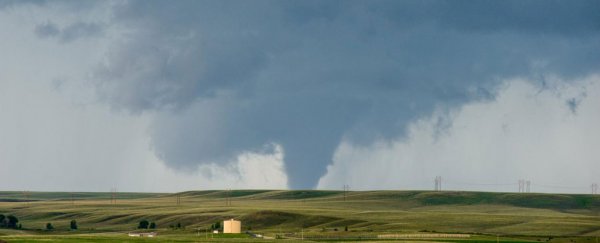If you're lucky, you and your family won't ever be seriously threatened by a tornado – but if the worst happens, chances are that tornado probably didn't come alone.
Tornado outbreaks – mega-storms in which a cluster of six or more tornadoes occur in close succession – are responsible for nearly 80 percent of tornado-related fatalities in the US. And the worst part is, these deadly chains of twisters have been getting even more intense in recent years.
Earlier in the year, researchers led by Columbia University found that the average number of tornadoes making up these outbreaks had risen since the 1950s, increasing from about 10 per year back then to about 15 per year now.
But new research published by the same team has found that something even scarier is going on.
Looking at records from the last 50 years, the researchers found that the frequency of US outbreaks with multiple tornadoes is increasing – and is rising faster for the most extreme outbreaks.
In the worst of these storms, outbreaks can contain dozens of individual twisters that collectively wreak havoc over a large region for days at a time.
Between 1965 and 2015, the researchers identified 435 of these extreme events, and during that timeframe, the membership in these mega-storms effectively doubled, from an estimated 40 twisters per outbreak in 1965 to nearly 80 in 2015.
Outside these trends, rogue outbreaks are even deadlier. The worst tornado outbreak ever occurred in 2011, spawning more than 360 tornadoes across the US and Canada, and killing some 348 people.
Before that, a 148-twister outbreak in 1974 claimed 319 victims.
But while freak storms like that don't fit into the overall patterns, it's clear that tornado outbreaks are getting worse, but why?
"It's not the expected signature of climate change," lead researcher Michael Tippett told Christopher Joyce at NPR, "it could be either something else, or we really don't understand what climate change is doing."
While the team did originally suspect that global warming could be tied to the tornado outbreaks, the data didn't bear that out.
The researchers analysed meteorological data sets generated by the National Oceanic and Atmospheric Administration (NOAA), looking out for two factors in particular.
One of these factors, called convective available potential energy (CAPE), is a measure of energy in the atmosphere; the other factor is a measure of vertical wind shear, called storm relative helicity.
Conventional modelling suggests that CAPE will increase in a warmer climate, which could induce greater storm activity.
But the data the researchers looked at suggested the rise in tornado outbreaks wasn't in line with CAPE, but instead with trends in storm relative helicity – which had not been projected to increase under climate change.
The upshot then is that we know tornado outbreaks are getting worse, but we don't know why – and as far as we can tell right now, it's not clearly linked to climate change.
"The findings are surprising," said one of the team, Joel Cohen, in a statement. "What's pushing this rise in extreme outbreaks is far from obvious in the present state of climate science."
Despite the ambiguity, other researchers say it's important to follow these trails as far as they go, as even the apparent dead ends help to increase our understanding of these changes in extreme weather patterns.
"The study is important because it addresses one of the hypotheses that has been raised to explain the observed change in number of tornadoes in outbreaks," says meteorologist Harold Brooks from the NOAA's National Severe Storms Laboratory, who was not involved with the study.
"Changes in CAPE can't explain the change. It seems that changes in shear are more important, but we don't yet understand why those have happened and if they're related to global warming."
If there is a definite answer, it's that there will be plenty more work needed to get to the bottom of what's inducing these deadly storms to swell so dangerously.
"We know temperature is going up, we know some things pretty sure, but the details of the weather – there's a lot more uncertainty," Tippett told Grennan Milliken at Motherboard.
"The answer to the question can tell us what to expect in the future. That's why we think it's an important question."
